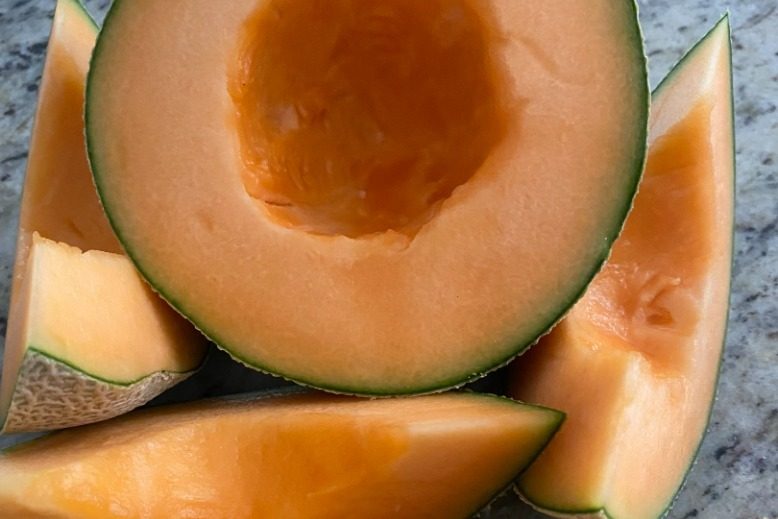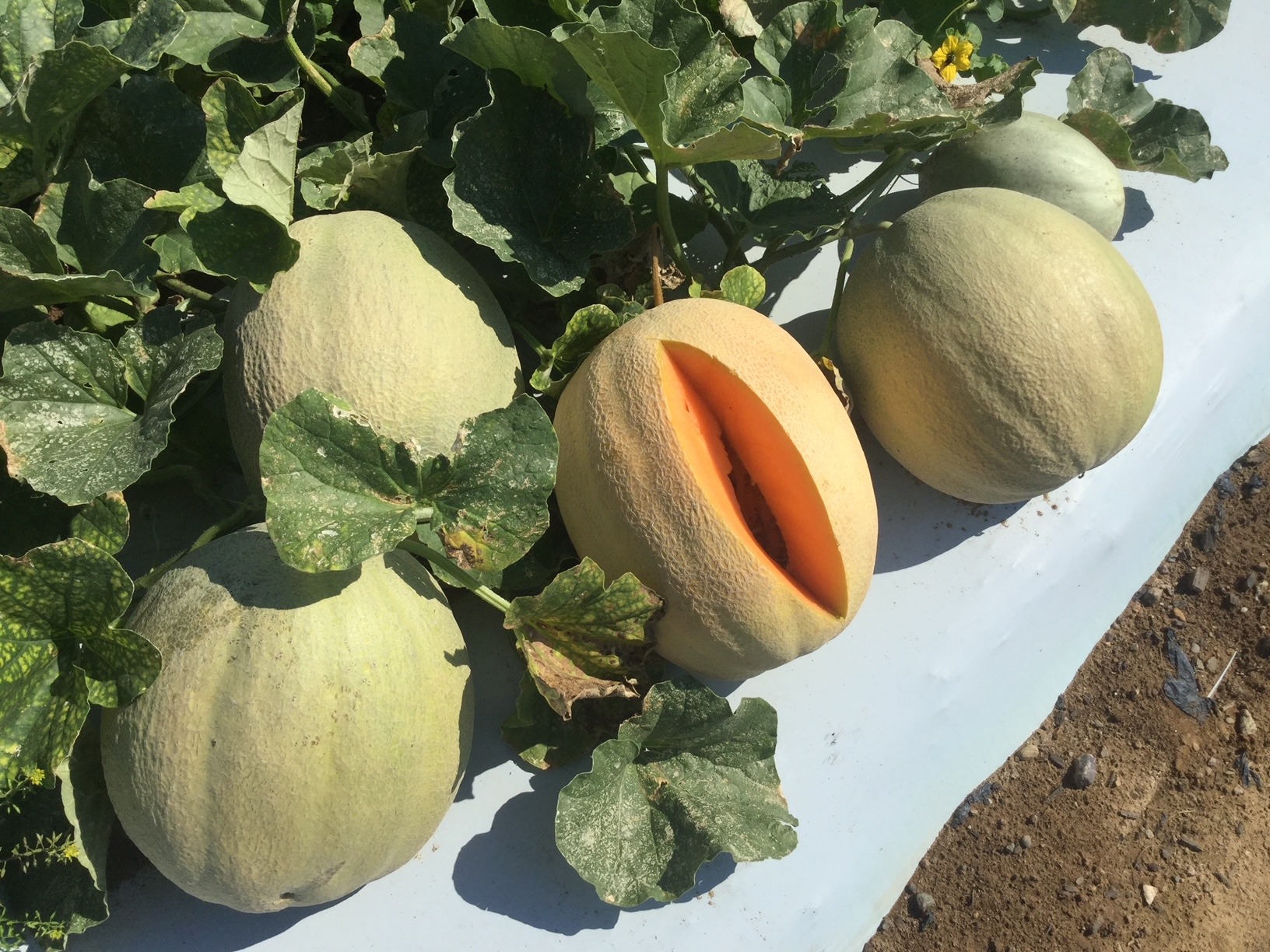
In our family business (Napolitano’s Produce in Bergenfield) in the 1950s and ’60s, my father would bring loads of cantaloupe into the store to sell in the summer, and you could smell their sweet scent for miles. Unfortunately, however, the melons would last only a day or two before they went bad. That’s why most stores today sell popular California cantaloupes, which are high in sugar and are good keepers that usually last up to a week.
New Jersey famously grows a type of cantaloupe called the “Athena” (years ago, we called them muskmelons), which are usually sweet with very soft flesh and are highly perishable.
SEASON AND VARIETIES
Great fragrance is the hallmark of a good ripe cantaloupe, and the warm, rich, sweet summer smell of melons is always the first thing that hits me. Inexpensive and highly popular, cantaloupes are sweet, fragrant and juicy, with a pinkish-orange to bright orange flesh. Grown primarily in California and other western states, cantaloupes are round with a golden, tightly netted skin.
Although good cantaloupes from the west are available from June through December, they’re best between June and September, when the California crop is at its peak. I think that California grows the best cantaloupes, followed by Arizona, New Mexico and Texas. From December through February, cantaloupes will be imported from Central America; these aren’t as good as summer cantaloupes from the U.S., but over the last few years, their quality has improved, and their price has become more reasonable.
Muskmelons, grown right here in New Jersey at local farms such as Farms View Farm Market & Garden Center in Wayne (which will have them until the end of September, pending good weather), have a memorable taste arising from their unique combination of flavor, texture and sweetness. Specifically, sugars are pumped into the fruit from the leaves as the fruit matures; once harvested, the fruit receives no more sugar but will continue to undergo changes in flavor and texture. For that reason, it’s better to leave melons on the vine as long as possible so they can reach peak sweetness and optimal taste.

Produce Pete discusses how melons are grown during a recent field segment filmed at Farms View in Wayne for NBC Weekend Today in New York. Courtesy of Pete Napolitano/NBC
Cantaloupes and muskmelons are harvested by their degree of “slip,” or ease of detachment from the vine. Melons at “full-slip” are fully mature and at peak flavor. Locally grown melons are usually harvested at full-slip, which is why they generally taste better than melons shipped from other production areas and harvested at quarter- or half-slip (which renders them firmer and better able to endure the long trip). In a home garden or at a local farm stand, however, take advantage of muskmelons and cantaloupes that are harvested ripe to enjoy this great taste of summer.
SELECTION AND STORAGE
Though many people believe that softness at the stem end is the best measure of a melon’s ripeness, in actuality, color and, more importantly, fragrance are what truly indicate ripeness—a cantaloupe with a golden color and ripe, sweet aroma is going to be a ripe, sweet melon. I actually encourage people not to push the stem end because if everyone presses their thumb there as they come through the store, eventually you’re going to feel something soft even if the melon is grass green and immature.
A mature cantaloupe will be well-netted or webbed with a smoothly rounded, depressed scar at the stem end. For some reason, cantaloupes with tighter netting seem to have a firmer, crisper texture and cut better than those with looser, more open netting.
When selecting a melon, avoid a shriveled, flabby or badly bruised melon or one whose stem end is rough with portions of the stem remaining, which reveals that it was harvested prematurely. Also avoid melons with growth cracks, mottling, mold or soft sunken spots on the surface or other signs of decay.

During a recent field segment filmed at Farms View in Wayne for NBC Weekend Today in New York, Produce Pete showed how cantaloupes grow on a vine. Courtesy of Pete Napolitano/Farms View
A cantaloupe that looks a bit green will ripen if you leave it at room temperature until any green undertones in the rind have turned golden and the melon has a rich smell. But during the summer, there’s no need to take home a green melon, as in-season melons should have been picked fully mature and ripe, with little or no green showing.
When ready to eat, cantaloupe will take on a yellow background appearance, acquire an aroma and soften. Because cantaloupe is shipped in a firm state to avoid damage, it usually needs a few days at room temperature to soften and become juicier.
PREPARATION
I think melons have a better taste and texture at room temperature, but if you like your melon chilled, refrigerate it right before you’re going to eat it. Once cut, melons have to be refrigerated, so wrap them tightly in plastic to preserve their moisture. Better yet, if you don’t want everything in your refrigerator to smell and taste like cantaloupes (and vice versa), it’s a good idea to put the melon in a heavy plastic or glass container with a tightly fitting lid.
High in carotene, fiber and vitamins A and C, cantaloupes are great eaten as is for breakfast or dessert or cut up with other melons and fruits in a salad. Because cantaloupe is easy to cut, it can be used as an appetizer, in salads, as part of a breakfast plate and in compotes and desserts.
I love eating cantaloupe raw, but in the summer, my wife, Bette, especially loves to make an easy cantaloupe sorbet—no ice cream maker required!—based on the following recipe from A Sweet Pea Chef with Lacey Baier. It’s refreshing, low-calorie and bursting with fresh fruit flavor, perfect for these warm summer days!
Cantaloupe Sorbet
Courtesy of A Sweet Pea Chef with Lacey Baier
Makes 4 servings
INGREDIENTS:
- 4½ cups fresh cantaloupe (1 medium cantaloupe), cubed
- 1 tablespoon freshly squeezed lemon juice
- 2 tablespoons raw honey
- 2 tablespoons water plus more as needed
INSTRUCTIONS:
Line a baking sheet with parchment paper and place the cubed cantaloupe onto the baking sheet, leaving space in between the cubes to allow for even freezing and not touching so they don’t create a giant glob of frozen cantaloupe. Place the tray into the freezer and freeze the cantaloupe overnight or until completely frozen (at least 4–6 hours). Place the frozen cantaloupe into the bowl of a food processor and pulse until the cantaloupe becomes crumbly. Add the lemon juice, honey and water and then pulse again. You may need to add more water until the mixture becomes more fluid, but not slushy (you’re looking for a soft sorbet texture at this point). Taste it and add any additional honey as necessary at this time if it needs to be a little sweeter. If the mixture becomes too slushy and doesn’t resemble sorbet, you can return it to the freezer for 30–60 minutes to allow it to re-solidify. Serve immediately, or store it in the freezer in an airtight container for up to 2 weeks.
About “Produce Pete” Napolitano
With over 65 years of experience in the produce industry, New Jersey’s own “Produce Pete” Napolitano is a renowned fruit and vegetable expert, author and television personality who’s appeared on a highly popular segment on NBC’s Weekend Today in New York, broadcast every Saturday morning for over 27 years. For more information, visit Pete’s website.
About Susan Bloom
A contributor to New Jersey Monthly and a variety of other well-known local and national publications, Susan Bloom is an award-winning, New Jersey–based freelance writer who covers topics ranging from health and lifestyle to business, food and more. She’s collaborated with “Produce Pete” on a broad range of articles for more than a decade.
